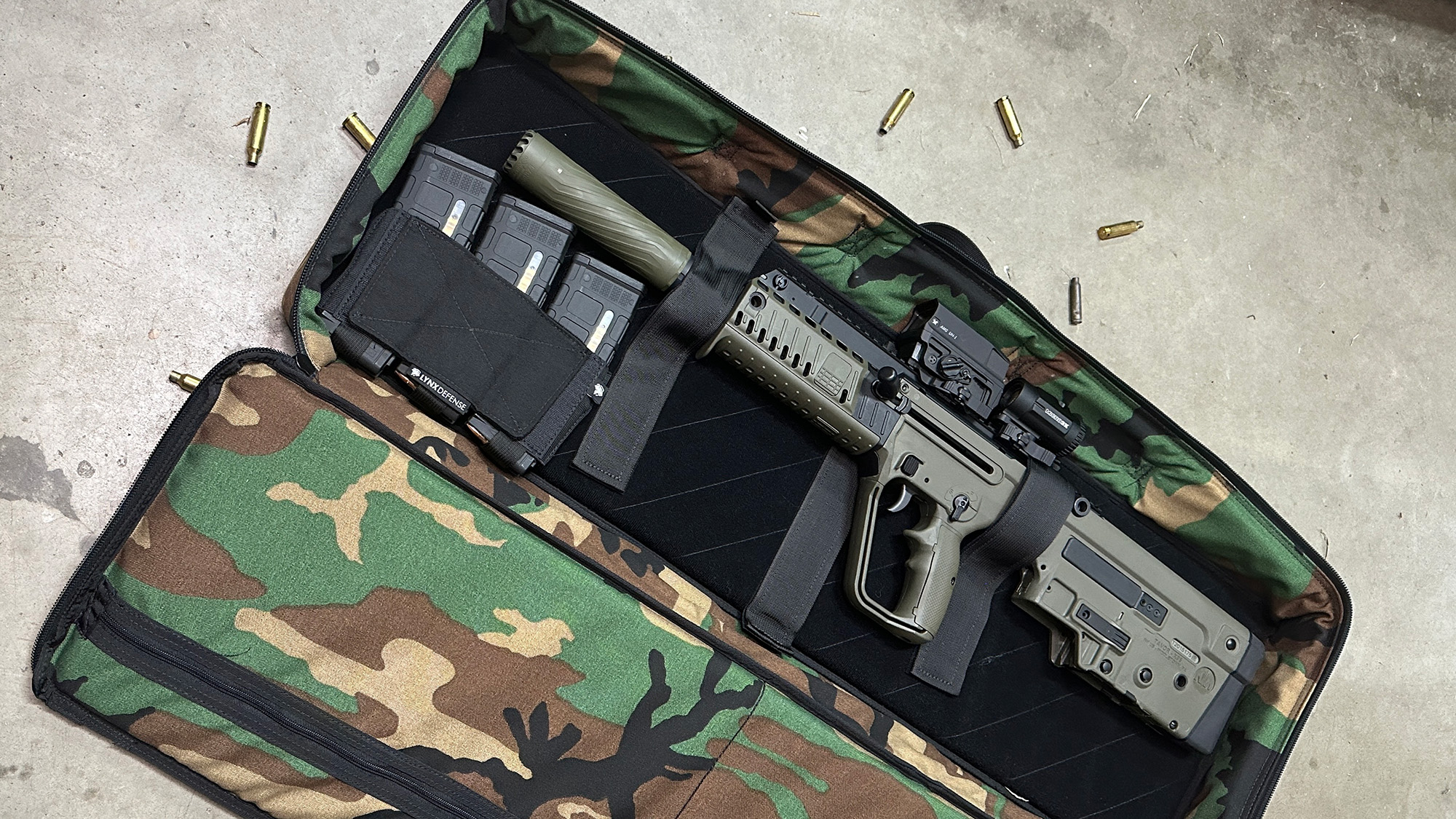
Ready to see what we have coming?
Lynx Defense will release some new things soon. Let us deliver them right to your inbox!

Lynx Defense will release some new things soon. Let us deliver them right to your inbox!
We may earn revenue from product links on this page and participate in affiliate programs. Learn More ›
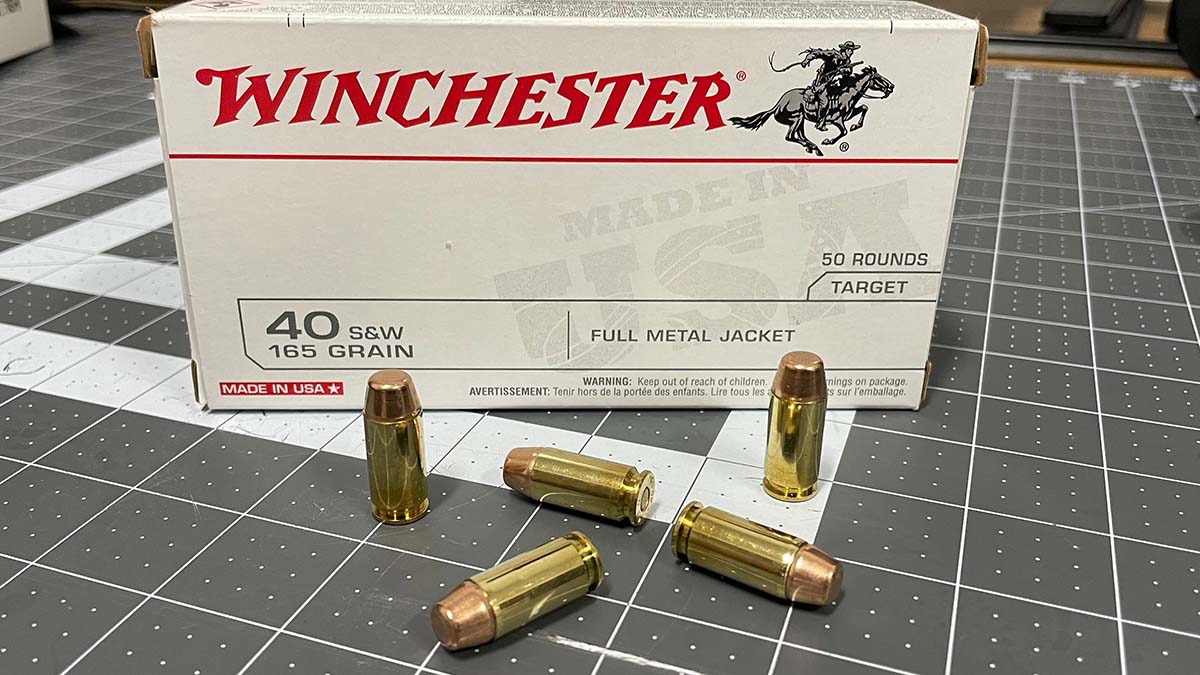
The .40 S&W is a caliber that has seemed to lose its steam in the last few years due to the majority of Law Enforcement and 3-letter Federal agencies switching back over to 9mm caliber pistols.
But .40 S&W is still a relevant caliber and shouldn’t just be pushed to the wayside as many enthusiasts still love the round and carry it daily.
The .40 S&W is a rimless straight pistol cartridge that uses small pistol primers.
The .40 S&W began its development after the 1986 Miami shootout involving the FBI where two agents were killed and another five wounded.
The agents at the time were carrying their service revolvers (chambered in .357), pistols (chambered in 9mm), and shotguns.
The aftermath of this incident caused the FBI to begin looking for a new caliber to take the place of its service revolvers.
This new round needed to offer increased capacity and had to deliver performance greater than or equal to that of the load currently carried by agents.
After extensive testing, S&W joined with Winchester to give birth to this new caliber.
Thus, the .40 S&W was born.
The .40 S&W was developed in order to be retrofitted for medium-frame handguns while replicating the performance of the 10mm Auto cartridge.
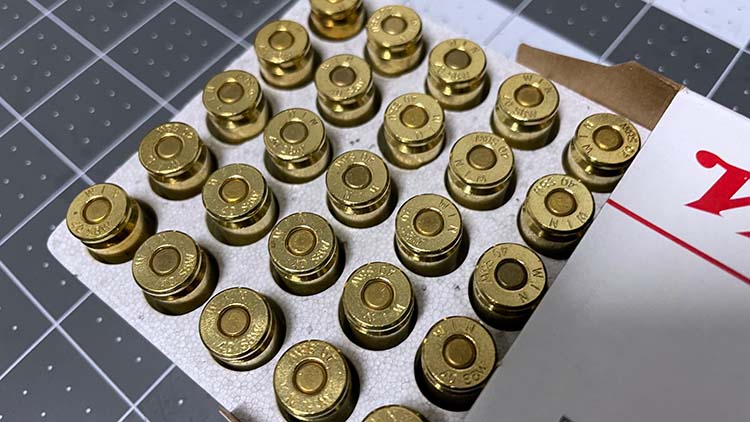
By streamlining the 10mm Auto, Smith & Wesson found they could remove the airspace in the case and decrease the 10mm case enough to fit an average 9mm semi-auto pistol frame.
This also allowed them to produce an 18- grain projectile that produced near-identical velocity to that of the FBI’s standards.
The .40 S&W is an ideal round for everyday carry (EDC) or home protection.
There is a wide variety of loads for your .40 S&W with most being between 155-180 grain. I’ll touch on a few of these below.
A 155 grain Federal HST cartridge produces approximately 1,160 ft/s at the muzzle and 463-foot lbs of energy on target. Compare that to the 115 grain 9mm which comes in at 1,180 feet per second and 355-foot lbs on target.
The 165 grain Winchester FMJ (as pictured) has a muzzle velocity of 1,060 ft/s and 413-foot lbs on target.
A 180-grain bullet will typically get a muzzle velocity of about 990fps with 392 ft-lbs of energy on target. This equates to about 904 fps at 100 yds all the while retaining 84 percent of its initial energy
You shouldn’t have an issue finding a pistol chambered in .40 S&W. Even though its popularity has waned in the last few years there is still a large market of available firearms from all of the major manufacturers.
The Glock 22 was introduced in early 1990 and was one of Glock’s first pistols chambered in .40 S&W.
According to Glock’s own website, it is “the most popular police service pistol in the United States.” However, I believe that statement might be a bit dated since even the FBI was turned back to 9mm.
This pistol chambered in .40 S&W packs in 15+1 rounds, a barrel length of 4.49-inch and width of just 1.26-inch.
If you’re shooting a Glock 22 for the first time and are used to shooting the full-size Glock 17 (9mm), you may be surprised at the similarities.
While you will notice the recoil of the 40 cal to be a bit more, your ability to get back on target will not be affected by much.
Being that the G22 has been around for more than 30 years, accessories are not hard to find.
If you have a Gen3 or newer any major manufacturer that produces weapon lights will have something for you. Such as the Surefire X300U.
When you’re looking for a holster for your G22, unless you are a giant of a human being you probably will not be looking for an IWB type holster (but options are available if you want to go this route).
Holster options are pretty vast when it comes to carrying your G22. You can take a look at the selection on We The People holsters.
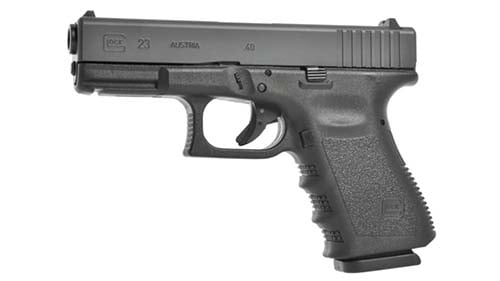
Like its bigger brother the Glock 22, the Glock 23 was introduced in early 1990. With a shorter barrel length of 4.02-in and a magazine capacity of 13+1, the G23 maintains an overall width of 1.26-inch.
When comparing shooting between the G22 and G23, you will notice a noticeable change in recoil.
This compact pistol allows you to use magazines from the G22 for an even greater capacity and, in my opinion, is one of the best guns to shoot (more on that below in the FAQ).
Personal preference will determine how you conceal your G23 and your choice of apparel for the day.
You can conceal this pistol in the most popular ways like the appendix or the 3’oclock position.
You’ll just have to take a sensible approach depending on where you’ll be carrying that day.
Just like for the G22 you have a wide variety of accessories at your disposal. From lights and lasers to mount on the rail, different aftermarket grip options, and magazine extensions to add more grip when you’re running your full-size magazines.
The options available for your G23 regarding holsters are almost limitless.
Whether it be OWB or IWB you should not have a problem finding a holster that can fit your needs.
My personal favorite IWB holster is Harry’s Holsters Singleton holster.
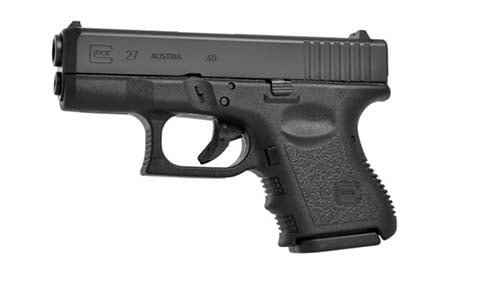
For shooters looking for a sub-compact carry pistol, Glock has an answer for that as well in their Glock 27.
Coming standard with a 9-round capacity and 3.43-inch barrel you have an easily concealable option chambered in .40S&W.
Another added benefit along with the Glock 23 is that all of the higher-capacity magazines are compatible.
Therefore, you could easily take your Glock 27 and have a 13 or 15 round capacity with a simple magazine change.
Smith and Wesson’s most popular pistol chambered in .40S&W is their M&P line.
Although, according to their website, the full-size and compact M&P models are now being made in the 2.0 versions, you can find these pistols in factory new condition and still backed up by S&W’s lifetime service policy.
S&W has transitioned their .40 cal production to their M&P Shield line.
With a 1-inch profile for easy concealment and a 3.1-inch barrel, the S&W M&P Shield .40 offers single stack magazines in either 6 or 7 round capacity.
Springfield Armory also has a range of pistols in .40 S&W.
Their XD line of pistols offers a tactical model with a 5-inch barrel, a compact model with a 4-inch barrel, and a sub-compact in a 3-inch barrel.
Although I haven’t found any documentation on it, by looking at Springfield’s site, it appears they are only offering the XD .40 nowadays in state-compliant models.
This means the above-mentioned new models on their site only come with 10-round magazines. You can still find older models of the XD with higher capacities from multiple other sites or order larger capacity magazines.
Like most ammunition over the past few years, at one point, .40 was hard to find, but nowadays, it seems that just about every online retailer and gun store has .40 back in stock.
Beware of scam ammo websites.
Be sure to use vetted and trusted online ammo retailers.
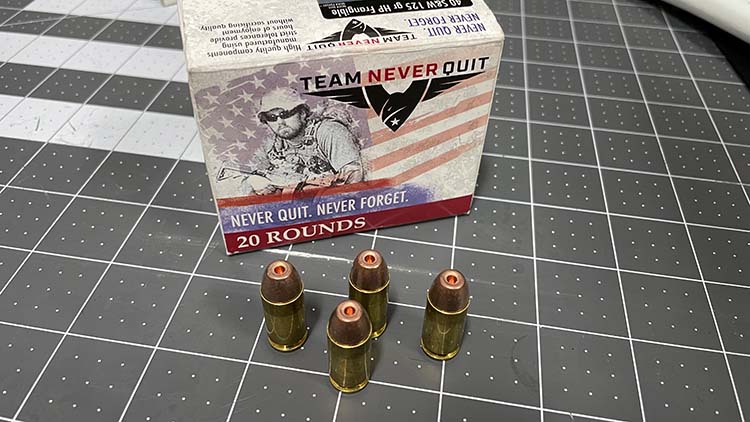
If you’re looking for in stock .40 ammo be sure to check out Brownells, Lucky Gunner, Palmetto State Armory, and Optics Planet.
On average, a 50-round box of FMJ will run you between $25-$35, which brings each round a little North of 0.50 cents per round.
I am sure you can find deals that bring this price point down a little, depending on the grain you are looking for, and most of the time, buying 40 S&W by the case will save you some money.
This debate has been going on for years, probably ever since the .40S&W came to be back in 1990.
But when you look at data and even with new technology that has been developed that makes the 9mm better the 40 cal still edges it out.
40 cal produces more energy and delivers more thermal energy on target to produce more lethal and larger wound channels on your intended target.
After receiving my CCW, the very first pistol I purchased for EDC was a Smith and Wesson M&P compact in .40 cal along with a Harry’s Holsters IWB holster.
Back then I didn’t know nearly what I do now about firearms but went with S&W because it happened to be at the gun store I was shopping at and was reasonably priced for a concealed carry pistol for a college student.
With that being said, I liked the interchangeable grip sizes that came with the M&P and the ease of concealment it offered.
For whatever reason, I have always been drawn to sidearms chambered in .40 S&W.
Not long after the M&P purchase, I picked up a used Glock 22, and my love for Glock products began. I owned the M&P compact until I got out of college when I decided I wanted something a little bigger while still being able to conceal it relatively easily.
That is when I picked up my Glock 23 and haven’t looked back. In my opinion, the Glock 23 (Again from previous articles, you know I’m a Glock fanboy) is the best .40 caliber handgun on the market.
The Glock 23 is perfect for EDC while having a moderate magazine capacity.
The accessories available for the Glock 23 are seemingly endless. With newer models being available in Glock MOS models you can easily mount an optic giving you greater accuracy downrange.
Now I know there is always going to be the debate about switching to 9mm over the .40 but I have shot thousands of rounds of .40 compared to 9mm.
It is a comfort factor to me, I feel like as a shooter I can manage the recoil that comes with the heavier weight of a .40 caliber round comparable to that of the 9mm.
The size of the pistol gives me many different carry options whether I want to carry an appendix carry, have it in the small of my back, or a paddle style holster.
Other than some of the family firearms in my collection that have been passed down from my grandfather and father, my Glock 23 is one that will always be a part of my collection and one that I will always feel comfortable with when it comes to the protection of my family and myself.
While there are many similarities between 9mm and .40 S&W there are also differences between both that make each respected in their own right.
The 9mm was released in 1901 and has stood the test of time. Coming standard in around 115-147 grains, 9mm offers the shooter accomplishable recoil and a decent amount of power.
As I have mentioned previously the .40 S&W has been around since 1990 and was developed specifically for Law Enforcement.
.40 S&W by and large comes in between 88 and 205 grains and was created to not limit the load capacity but also increase the stopping power of the FBI’s carry round.
The heavy bullets that .40 S&W offers have terrific stopping power and lethality on target.
This decision is one I cannot make.
This comes down to what you are comfortable with and if you are willing to practice and accept the recoil that comes with a .40 caliber pistol then this may be the round for you.
You have many options to choose from when it comes to weapons, loads, and accessories available for .40 cal.
If owning a .40 caliber pistol is what you want to go with, you will get a round that is tried and tested and one that is more than capable of protecting you and your family no matter what the scenario.
Be sure to read more of our ammo articles and if you want one specifically made by Smith & Wesson like the 40 caliber take a look at the 460 S&W.
If you have criticism about recoil, or accuracy with the 40, then you are not going to the range as often as you should.
Not trying to offend anyone, but I started Law enforcement in the early 1960’s with a department supplied S&W K38 revolver. So I never did get Glock fever. I tend to agree with the above reading, especially about Underwood Ammo. Despite the fact I have both 9mm and S&W .40’s my personal preference is the .40 S&W. I just wear a fluffier shirt in the summer to help cover up my gun. No matter your preference, you need to practice weekly. Rather than shooting a box or 2 monthly, shoot 5 or 10 rounds at the range weekly. Despite the fact it may be a little more expensive, shoot the same ammo at the range in practice as your EDC.
I see these comparisons far too often. They never seem to give the 40 S&W the credit it deserves. Before I get into the how and why let me start by stating that I like 9mm and 40, and own plenty of guns chambered in both. I also reload for both and know the limits of each cartridge. I am lucky enough to own my own shooting range which allows me to perform various test. Now, the difference between these two cartridges has been rumored to be negligible. This is only true for the watered down big box factory defense loads. Comparing apples to apples, or in this case “best to best” the scale shifts in favor of the 40 quickly. I can back my claims with facts and science. The best(most energetic) 9mm I can find in a factory loading is by none other than Underwood. This load is a 115 grain hp moving at 1400 FPS. This equates to just over 500 fpe. That’s a respectable number. Keep in mind this is a +p+ load so it’s not for every gun and its recoil will be noticeably sharper than that of a standard 9mm. Now you know the most energetic 9mm factory load on the market let’s discuss the hottest 40 S&W load. It too is brought to us by Underwood. It’s a 135 gr hp traveling 1400 FPS. This is not +p+, in fact it’s not even max pressure which is 35k psi. The 40 S&W can push a 20 grain heavier bullet to the same velocity as the 9mm load, and have a 1 mm advantage in diameter. So the 40 can produce nearly 600 fpe and can easily exceed that with proper hand loads. This is more powerful than most 357 magnum loads, and it’s a larger diameter bullet. I have loaded 135 and 155 grain 40 loads to exceed 650 fpe. I have a max pressure load for my USP, P226, and XDM that pushes a 135 gr to over 1500 FPS. It takes a longer barrel (>4.5”) granted but that’s well into 10mm auto territory. I’ve yet to see any ill effects to my guns or brass. I only fire this max pressure load in my full sized 40’s with upgraded heavy recoil springs and fully supported chambers. No 9mm or even 45 acp can reach this level of power. With exception of the 45 super, which in my opinion is the king of semi-auto pistol calibers. So if one compares the best of each offering you can see the 40 is the clear winner. In most of these articles I see the author test heavy watered down 40 loads against light weight 9mm performance loads. The 40 has a larger, heavier, and faster projectile that really doesn’t have a noticeable difference in felt recoil when you compare it to performance 9mm ammunition. You get magnum like performance in a small package. Feel free to fact check me. The 40 is in my very unbiased opinion the best all around self defense cartridge for concealed carry, especially in smaller single stack guns that are designed for the 40 cartridge. Many of the 40 caliber handgun manufactures simply re-barreled their 9mm framed handguns and machined a bigger hole in the slide and voila, you now have a 40 s&w. Except they forgot that the 40 operates at a higher pressure than 9mm causing accelerated wear on those platforms. Other companies, like HK and Sig made guns specifically to handle the 40’s bark. They don’t suffer from the accelerated wear that the inferior pistols are prone to. The 9mm is still in my opinion a great cartridge and with good shot placement and high performance ammunition it is a great self defense option. I prefer to have the odds stacked in my favor so I choose to carry a 40 for my EDC over the 9mm. That being said I wouldn’t feel underdressed if stuck carrying a 9mm, I would just have to focus more on shot placement if the need arises. Practice with whatever you intend to protect yourself and/or others with and become proficient and confident with that weapon. My only advice is make sure it is at the very least a 9mm. Don’t be a sheep in the media controlled heard, question everything and do some research before following the crowd. Just because the FBI dropped the 40 in favor of the 9mm doesn’t mean the 40 is inferior in any way. In fact it’s quite the opposite, but they have their reasons. I believe those reasons revolve around poor shooting techniques resulting in bad qualification scores, subpar guns for the caliber “cough-cough Glock” resulting in accelerated wear of the firearm, and higher ammo costs. I also believe the 40 S&W ammo they were using is a terrible representation of what the cartridge is capable of. I mean why the 180 grain? Don’t they know there’s more energy in the lighter loads like the 135, 155, and 165 grain bullets? The 180’s take up too much case capacity resulting in anemic performance. The FBI’s penetration requirements are still easily achievable with these lighter bullets with today’s bullet technology. Whatever the FBI’s reason I find it extremely hard to believe it was caliber performance related. If it was, I would like to know what watered down garbage load they were testing against the 9mm to reach such a ridiculous outcome. Probably the Winchester 180 grain. If the FBI would just come clean and say it’s because the 40’s snappy recoil hurt their widdle hands I would accept their migration to the inferior cartridge. Don’t feed me that 3 shot to incapacitation statistic for 9,40, and 45. I know they were shooting garbage 40 loads that big ammo manufactures force fed every police department in North America. It’s either the subsonic 180 grain crap or the 155 grain that only goes about 150 fps faster than it’s overweight 180 grain counterpart. It’s like putting a 4 cylinder in a corvette. It’s capable of so much more. Underwood loads the 155 grain hollow points to 1,300 fps. That’s 150 fps faster than the 155 grain load most police departments carry. I would rather see them using the 135 grain loads to help prevent over penetration and possible collateral damage while delivering more energy on target. I really couldn’t care less about what cartridge the FBI uses, but it seems that everyone else bases their next move on what decision the suits make. Because of this heard mentality people are making it so manufacturers are discontinuing current models chambered in 40 and are not making any future plans with the cartridge. It would seem that the gun community is no less immune to influence than a liberal watching CNN and surfing Facebook. What happened to a critical thinking America?
Uh why wouldn’t it still be a good caliber ? Have us Humans evolved into a bullet proof species ? The .38 Special is a good SD round. It killed Lee Harvey Oswald with one gut shot. The only reason LEO’s changed is to add more rounds to their pistols to keep up with the bad guys. The .38 bullet is still lethal. People say that the 9mm has improved over the years. I agree but so has ALL calibers, including the .40 caliber. About this time is when the “Gurus” point out that they can hold up to 3 extra rounds of 9mm in a comparable size 9mm. OK, true. Unlike the police who may actually get into a gun fight and run through 18 rounds of 9mm us civilians are MUCH more likely to ever need our SD gun much less shoot all the rounds in a clip. Remember, that you ole wise citizen are legally responsible for EVERY round that comes out of your gun in a court of law. That’s true of the police as well. I continue to read where 9mm fails to stop a bad guy much more often than I do where someone runs their clip empty and had to run like hell. Ballistic gel test are just for water cooler talks and have no real merit in real shootings involving the human body with skin, bone muscle and such. To each their own but back to the point. Is .40 still a gun SD round. Yes. It will kill your ass door nail dead. Next time you go to a pond, find a rock about the size of a marble or so and throw it into the water as fast as you can. Note how far the ripples of water fan out. Then find one a shade bigger and through it in but about 20% slower. Did the ripples fan out further ? Bet they did. You know why ? Because the bigger rock had more of an impact on the surface. That is because it made more of an impact on the water surface. Same concept with a bullet and I won’t even get into over penetration from several 9mm rounds than could pose a serious problem. So, I will give up those extra couple of rounds knowing I’ll most likely never need more than 4 or 5 shots for that extra punch on the impact. That’s just me. Like I said, to each their own.
I have a glock 23 that I bought in 1993,
After 30,000 rounds, I replaced upper components and lower components( just to be safe)…. Still
Have it, still shooting it…. ❤️
Having carried the Glock 22 for the last several years of my career, I purchased a couple of .40 carbines with 16” barrels. Does anyone have data/opinions on which .40 cartridge is most powerful coming out of a 16” barrel?
The 40 S&W is still being used by police departments for a reason. Mainly the 100 extra foot pounds of energy. You can only shoot up to a 147 grain boolit in a 9mm, but it slows the velosity to the same as a 40 S&W shooting a 180 grain boolit. BIG difference. I never have a problem finding ammo for either the 9 or the 40. You are basically are about half way or better to the performance of the 10mm without the increased cost and recoil of the 10mm. I have, and shoot all three. The 10 will beat you up a bit at the range “if” you are shooting a fifty round box or more. The 40 S&W has a bit more felt recoil, or snap, than the 9mm. I feel much more safe here in the woods in Florida with the 40. We have hogs, black bears, panthers, and bobcats. Also some two legged creatures that make me feel much safer with my 40. to each his own. I find much better deals on 40 S&W ammo than on 9 or 10mm on local trade/sell sites and forums. Try all three at a range and do some testing on water jugs. So much fun to practice on.
I too love the 40 caliber and just feel more confident with the extra recoil. I have a MP20 Performance Center 40 cal S&W and love it. I reload my own and shoot a couple times a week.Learn to shoot the 40 S&W and you will never pick up a 9mm again.